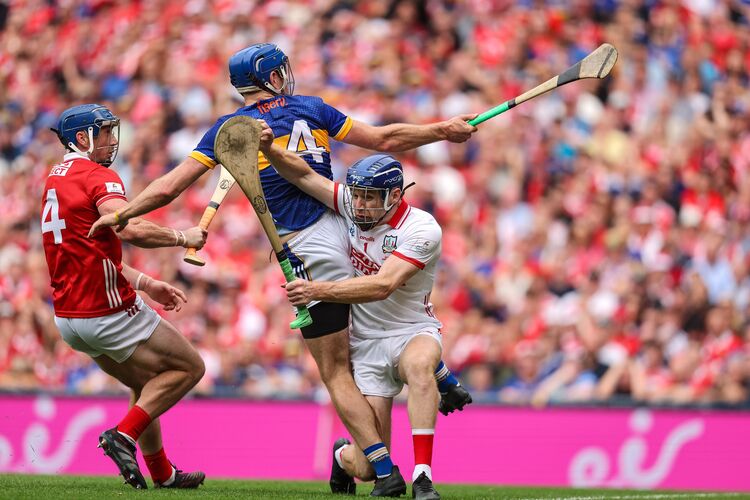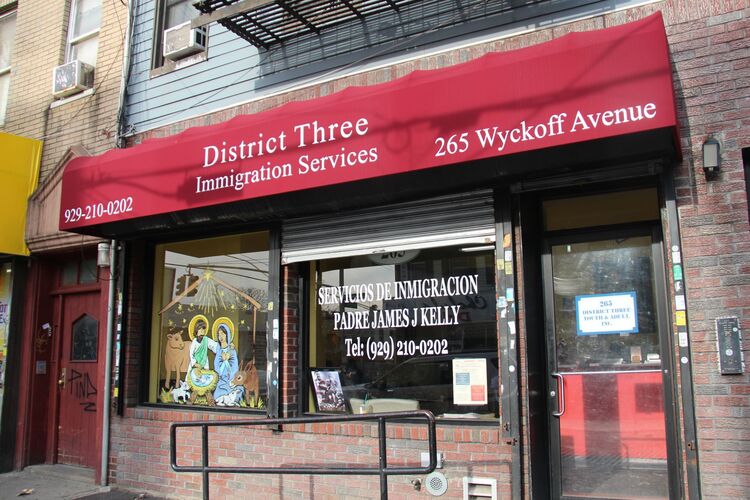By Peter McDermott
Every once in a while, Cheryl Reilly's 72-year-old uncle comes into Manhattan from Queens and "goes on the toot." He wanders the streets and the parts of the old neighborhood -- Inwood. Once he even knocked on a stranger's door and asked if he look around the apartment where he was born. The response was less than positive.
"He walks around with tears in his eyes," she said. Reilly, 51, who still lives in the neighborhood, knows how her uncle feels. It's the end of the line for a multigenerational ethnic community. "My children went to the same school, Good Shepherd, that their grandparents went to," she said. "It was a great place to bring up children. Everybody was church-going and hard-working. The streets were clean and safe." Now she reckons that the great majority of Inwood's Irish community are older than her.
The Irish were attached to the Inwood story, which usually began with the Algonquin Indians -- who had a settlement in what became Inwood Hill Park -- and progressed in short order to the IND subway line, the steelworkers and transit workers, and the multitudinous bars. But at some point things went awry.
In a chapter on Inwood and Washington Heights in "The New York Irish," Robert W. Snyder writes: "The Irish of northern Manhattan truly feel that their old world was invaded and conquered by Latinos." A few years on, Irish resentment at Dominican succession is less palpable. People have come to terms with reality; the day of the white ethnic community has passed in Manhattan. Destiny has brought the Jews, the Italians and the Irish to the suburbs; it's brought the Inwood Irish in particular, it seems, to Long Beach, L.I., and Pearl River.
Nonetheless, there are several hundred Irish-born and Irish American residents still living in the community. Many could live with family in New Jersey or upstate or Long Island, but they choose to stay. "They don't want to go," said Mary O'Sullivan of the Tara Irish Gift Shop on 207th Street at Broadway. Now, in a new twist in Inwood's history, young professionals and artists are joining them in this increasingly multi-ethnic neighborhood.
The Irish, though, can't help but reflect on the time when Inwood was theirs. "They once practiced Gaelic Football in Insham Park," said O'Sullivan, recalling a time when Inwood was still alive with young Irish immigrants. "The Inwood club won plenty of championships," said Bill McKenna, who emigrated from Tipperary in 1957. At one time it had more trophies than any club in the Minor Board, he said.
These days the Irish don't play football in Isham Park, but they can be found sitting on its benches. And they're also to be seen praying every day in Good Shepherd church. After 12 o'clock Mass, some gather for lunch in favorite haunts like the Capitol Restaurant or the Piper's Kilt.
The Irish bar survives
There are still a few bars catering to the Irish community, but not quite as many as in the old days. "There were a lot of watering holes," Reilly said. "This was a drinkin' neighborhood," said Gene Duffy, who recalled that there more than 80 bars along one stretch. "All doin' good," he added.
The very name of one of those remaining, Keenan's Piano Lounge, is reminiscent of another age. The piano is long gone, but Keenan's can legitimately hold onto the name. "I was here for two years before somebody pointed out to me that the place is in the shape of a piano," said barman David Delaney, a native of Stonybatter in Dublin City. On a recent Saturday afternoon, Delaney tended to his regulars while young brown faces passed by on Broadway, happily oblivious to the lost world inside.
"We had this town tied up once," said 86-year-old Paddy Shelly, farther up Broadway in the Liffey, a bar favored by Irish-born residents. Shelly left Tipperary for America at age 17 in 1929, the year of the Wall Street crash. He was warned to stay clear of downtown Manhattan because people were jumping out of windows. His generation of immigrants struggled through. "We didn't set the world on fire, but we didn't want to set it on fire," he said. "We did good, though."
Like most of the Irish left in Inwood, Shelly lives to the west of Broadway. "This section is still fairly good," he said. "There are different nationalities, but we're still hanging in here." In the old days, the working-class Irish, Jews and Italians lived in the street east of Broadway, in apartments that somebody once described as "grim but comfortable."
Now as their economic position improves, Hispanic residents are following the Irish to the more desirable residences on the West Side. "You're all set if you speak Spanish," said one Irish American about his West Side street. And it's these pre-war apartments with their competitive rents that are drawing the younger, middle-class tenants from downtown.
The Irish originally came from downtown as well. In another chapter in "The New York Irish," historian Marion R. Casey shows that the Irish, constantly seeking out better living conditions in the city, were geographically mobile long before they were upwardly mobile. And Inwood was a desirable and interesting place to come to. It was convenient too, when they completed the IND line in 1932.
Gene Duffy came with his parents and Irish-born grandparents to Inwood from 100th Street before that. The year was 1927. He was, he said, 6 or 7 then. Now his family, which includes five great-grandchildren, are scattered throughout the United States. The Great Depression came near the beginning of his seven-decade residency in Inwood. "Everybody had it tough," he said. He remembers that the family got care packages from Good Shepherd. "My parents didn't go. I went. My father had too much pride," he said.
A neighborhood takes shape
Yet the 1930s was also a time of progress. The WPA Guide to New York City reported in 1939: "For all of Inwood's considerable age, there is a newness to much of the district. The apartment houses and the spectacular improvements in parks, bridges and highways are, for the most part, recent achievements."
Older residents remember the neighborhood taking shape. Veronica Carney can recall when the block, which is now home to the telephone company, on 214th and 215th Streets, was a vegetable farm. "Good Shepherd was just a small country church then," she said. In the mid-1930s, the Paulist Fathers decided to replace it with the present structure. "They moved the old one on rollers," she said. Gene Duffy can recall when the Presbyterian church was moved to a different street in the same way. "They let us play basketball in the church, even though we were Catholics," he said. "We cheered like Protestants."
Duffy would have a varied career when he grew up. "I worked in a bank, I was a longshoreman for a year, was in the Merchant Marine for a time. And I was an ironworker for 30 years," he said. "At one time, 70 percent of the guys here were in construction."
Duffy also served in the U.S. army in Europe during World War II, and his two sons served in Vietnam. "We used to have one of the best Veteran's Day parades in the city," he said. His local bar, Patrick's Pub, keeps the flag flying with veterans' and MIA stickers on the door.
Cheryl Reilly wanted a reminder in her bar, Irish Eyes, so she hung a framed photo of someone paying respects at the Vietnam memorial in Washington, D.C. "The Vietnam War is very important to me. That's my generation. Eleven kids from this neighborhood were killed. All Irish American. And a lot came back not the same mentally," she said. "They were drafted from high school. But they wanted to do what their forefathers did before them."
"It's always been about the red, white and blue for me more than the green, white and gold," Reilly said. "But we were steeped in Irish culture. We grew up thinking a certain way about Ireland."
When Reilly was a small child, the Irish population of upper Manhattan reached a peak. Twenty-seven thousand of the first and second generation were counted in the census of 1950; they were concentrated in Good Shepherd parish and Incarnation parish, Washington Heights. (As the grandchildren of immigrants, Reilly and Duffy would not have been counted in that census as "Irish.")
It was at this point that what Snyder calls the "intensely shared streetlife" of the ethnic community began to erode. The suburbs beckoned. He writes: "Automobiles bought with good wages, highways built with government money, and homes purchased with federally subsidized mortgages all enable Irish of the financially secure working class and middle class to move to tree-lined streets that their parents had only imagined."
"Hasty retreat"
However the move to the suburbs took place against a backdrop of increasing crime and disorder and racial conflict in America's cities in the 1960s and '70s. The move from Inwood and the Heights seemed like "a hasty retreat," Snyder says.
The historians, such as Snyder, say the Irish did live in secure, relatively calm, close-knit neighborhoods in the 1930s, '40s and '50s. But there has been a tendency, they argue, to gloss over the less palatable facets of the past. For example, in the anti-Semitic climate of the 1930s, Irish young gangs and ultra-rightist groups targeted Jews in the neighborhoods of upper Manhattan.
Furthermore, historians argue, people underestimate how difficult assimilation has been for every new group; they seem unaware that the same charges leveled at Hispanics in recent decades had been thrown at the Irish in earlier generations.
The Catholic Church has been keen to promote the idea of ethnic succession. Fr. Patrick Traynor was a pastor in Good Shepherd from 1967 to 1970 and returned to the parish in recent times. He noticed great changes brought by the intervening years, but stresses the continuities. "About a quarter of the old people praying in the church during the day are Hispanic," he said. He now ministers to a hard-working, multi-ethnic -- if predominantly Hispanic -- community. There are 600 children in Good Shepherd's parish school. The parents want the best for their children, in the same way the Irish parents did before. "Many of our children go on to some of the best Catholic schools in the city," Traynor said.
There is also the same tradition of community service on behalf of the parish church and school. "We have a group called Caballeros en Accion," he said. "Any plastering, painting or plumbing work that needs to be done, they do it."
There is some interaction between the newer immigrants and the Irish. "But not as much as I would like," Traynor said. "But both groups do great work."
The new wave of professionals, among them singers and musicians, has been a boon to the parish, Traynor believes. Some of them formed the Inwood Opera Company, which stages several productions a year. "They put on some very nice shows," Veronica Carney said.
"It's a vibrant and exciting neighborhood now," said Cindy Burke, who has raised two daughters in the community. In her building she can hear musicians and singers practice daily, while on the streets she encounters the aromas of foods from many countries. "I like the fact that it's so mixed culturally," she said.
The Irish continue to maintain a presence, however. There's no shortage of specifically Irish and Irish-American events and activities on the social calendar, from regular ceilis to St. Patrick's Day parties. A popular event is the Saturday night social held at Irish Eyes. "People come back for that," Cheryl Reilly said. "It caters to a mature audience: my age group and older."
Inevitably, some things have suffered. "The Dyckman Social Club just fell apart when a lot of the younger guys moved away," Gene Duffy said. On the other hand, an organization like the Good Shepherd Men's Club has been able to count on active members who live outside the parish. The club hopes to have 600 at its upcoming 35th anniversary celebration.
"The Irish have incredible loyalty to this parish. I think it's because they built it out of nothing," Fr. Traynor said. Bill McKenna isn't surprised that people, among them his own children, come back often. "It's still Inwood, no matter what," he said.







